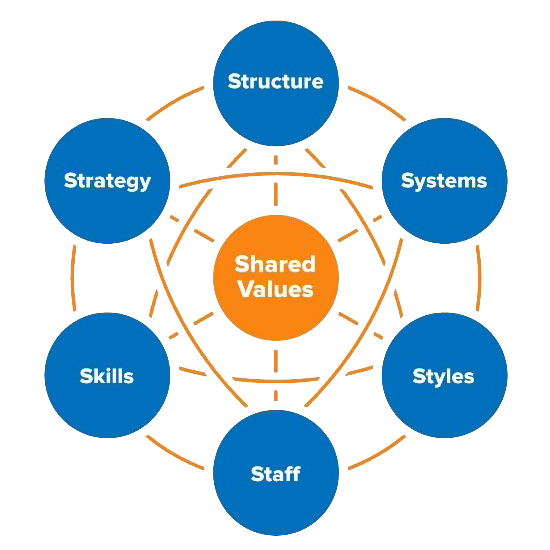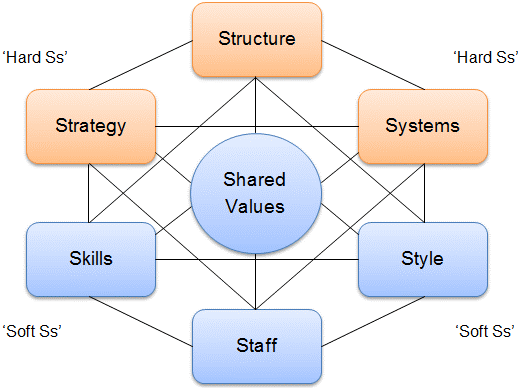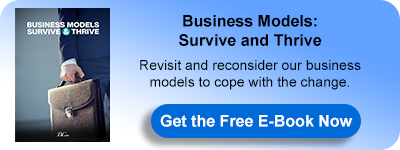The Mckinsey 7-S Model
What is the Mckinsey 7-S Model?1
The McKinsey 7s model is a tool that examines a company's organizational architecture by examining seven essential internal elements: strategy, structure, processes, shared values, style, employees, and skills to see if they are correctly aligned and allow the company to achieve its goals.
The framework can be used to examine the likely effects of future changes in the organization, thus can be utilized upon implementing the new business models that align with the organizational design and processes during a merger or acquisition. McKinsey's 7-S model can also be applied to elements of a team or a project.

The McKinsey 7-S Model2
Explaining the Model
Tom Peters, Robert Waterman, and Julien Philips, along with Richard Pascale and Anthony G. Athos, established the McKinsey 7s model in the 1980s. Academics and practitioners have widely utilized the model since its inception, and it is still one of the most prominent strategic planning tools. It emphasized human resources (Soft S) as a key to more extraordinary organizational performance, rather than the traditional mass production tangibles of capital, infrastructure, and equipment.
The model's purpose was to demonstrate how the company's seven elements, Structure, Strategy, Skills, Staff, Style, Systems, and Shared Values, may be aligned to create effectiveness. The model's main idea is that all seven sectors are interrelated, and changes in one area necessitate changes in the rest of the company for it to work efficiently. The McKinsey model, which depicts the linkages between seven areas and splits them into "Soft Ss" and "Hard Ss," is shown below. The model's form emphasizes the elements' connection.
Defining the 7S Factors
The seven organizational categories are separated into 'soft' and 'hard' areas in the McKinsey model. Compared to soft elements, strategy, structure, and systems are hard elements that are considerably easier to identify and manage. On the other hand, soft areas are the backbone of the business and are more likely to produce a persistent competitive advantage, although being more challenging to maintain.

Using the Mckinsey 7-S Model 3
Step 1: Determine which areas are not correctly aligned
The first stage's goal is to examine the 7S elements and determine whether they are effectively aligned with one another.
Step 2: Determine the best organizational structure
With top management's support, the second phase is to figure out what kind of effective organizational design you want to attain. You can define your goals and make action plans much easier if you know what alignment you want.
Step 3: Determine what adjustments should be made and where they should be done
This step is essentially your action plan, outlining the areas you wish to realign and how you intend to do it.
Step 4: Make the required adjustments
The most critical stage in any process, change, or analysis is implementation, and only well-implemented changes have favorable outcomes.
Step 5: Review the 7s regularly
Strategy, structure, systems, skills, staff, style, and values are dynamic and regularly change. Changes in one aspect always impact the others, necessitating the implementation of new organizational design. As a result, it is critical to check each region regularly.
1Strategic Management Insight, 20 Dec 2013, Ovidijus Jurevicius, Accessed 30 September 2021, https://strategicmanagementinsight.com/tools/mckinsey-7s-model-framework.html
Mindtools, Accessed 30 Sep 2021, https://www.mindtools.com/pages/article/newSTR_91.htm
2Figure reproduced with permission from McKinsey & Company, www.mckinsey.com. Copyright © 2016. All rights reserved.
3Strategic Management Insight, 7 Oct 2021, Ovidijus Jurevicius, Mckinsey 7S Model, Accessed 14 Oct 2021, https://strategicmanagementinsight.com/tools/mckinsey-7s-model-framework/
For more about this topic, download our latest book " Business Models: Survive and Thrive " for FREE:
